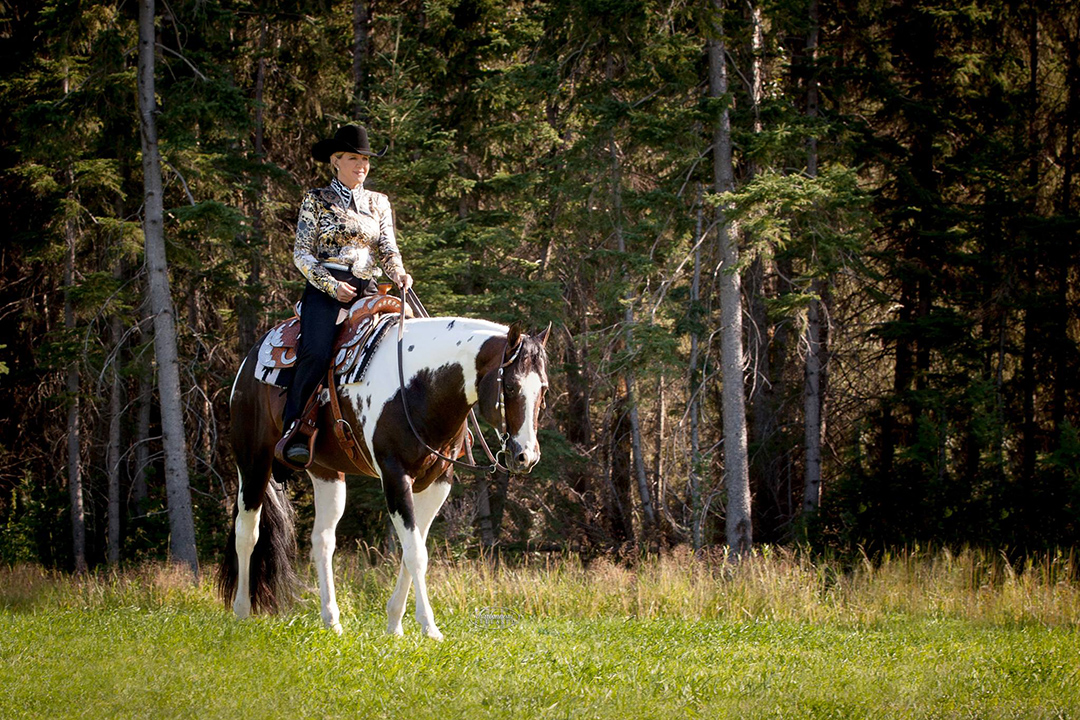
Healing a ‘heart horse’
The stallion wasn’t perfect. He was small, thought Laura Martin, with small feet.
By Jeanette NeufeldThen she rode him.
“Sure enough, he was just a Cadillac. He was beautiful. He did these beautiful flying lead changes exactly at the right places between the pylons,” she says. “He just took my breath away.”
It was 2013, and Martin and her husband Bruce had flown to Colorado to meet Pistol Packin Frekles, or “Pete” for short, a registered paint stallion and a potential new addition to their herd.
While Laura still had reservations, Bruce agreed to purchase the stallion. At the time, Laura didn’t know that Bruce was sick with an aggressive form of cancer. Without telling his wife, Bruce mortgaged their cattle herd to buy the valuable horse, and Pete joined their family that winter.
Bruce died 18 months later, and Pete carried Laura through her grief and into the show ring.
“[Bruce] had said to me: I wanted you to have that stallion, because I knew if you did, you would keep breeding horses and you would keep showing and training horses and doing what you loved, and that stallion would look after you financially,” says Martin.
And he did. The pair successfully showed across Western Canada, and gentle Pete learned to pasture breed, siring at least 15 paint foals that Martin raised and sold.
With all of that history between them, Martin knew she had to do everything she could to help when Pete — now 20 years old and gelded — became seriously ill last winter.
“I really wasn’t prepared to part with him yet,” she says.
Martin has more than 25 years of experience as a registered veterinary technologist in addition to her career as a certified riding instructor and horse judge. When Pete became lethargic, weak and unco-ordinated, she knew right away that something was wrong with her horse’s kidneys or liver.
Martin called the Western College of Veterinary Medicine’s Veterinary Medical Centre (VMC) and was soon visited by clinical associate Dr. Valentina Ragno, a board-certified specialist in large animal internal medicine and a member of the VMC’s equine field service.
Pete hadn’t been eating much, and he appeared very depressed. He also had some jaundice (yellowing) showing in his eyes and gums. Ragno performed an abdominal ultrasound examination, which showed an enlarged, congested liver.
“When we first examined him, he was severely ill,” says Ragno.
The equine field service team took a sample of Pete’s blood and brought it back to Prairie Diagnostic Services, the province’s veterinary diagnostic laboratory, for tests — including a complete blood count (CBC) and blood chemistry panel.
“From just our examination that day, we gave Laura a guarded prognosis, which usually means 50-50 for survival. Our hopes weren’t super high for him,” says Ragno.
Pete’s clinical signs and blood test results were consistent with equine hepatitis, the catch-all term for a disease affecting the horse’s liver. Since Ragno and her colleagues suspected a bacterial cause, they soon began an intensive course of antibiotic drugs as well as an anti-inflammatory medication.
It was a difficult time for Martin, who spent several weeks providing intensive care to her sick horse on her farm. Hospitalizing him was not an option for her, and Dr. Ragno created a tailored treatment plan to be implemented on the farm. One of the antibiotics was suppressing Pete’s appetite, so the clinical team had to switch to a rectal route that was difficult to administer — especially in the cold.
“Now it was 35 below, and I don’t have a heated barn. I would go out with my rectal enema and my warm oral antibiotics and give that to him three times a day,” she says.
Martin was surprised but happy when her horse’s health started to improve. About five weeks after his treatment began, Pete was on the mend.
“He knew what was going on. He wasn’t ready to check out. He knew I was trying, so he had to try,” says Martin.
It turns out Pete had more love and lessons to give. A valued member of Martin’s Painted River Ranch near St. Denis, Sask., Pete is a great teacher and patient with even the youngest riders.
For the VMC equine field service team members who worked with him, Pete’s recovery was a great example of teamwork between the owner and clinical team.
“We were all very excited because we were not super hopeful in the beginning, given his age and condition,” says Ragno. “We were just very grateful to Laura for all her efforts. That was fundamental.”
